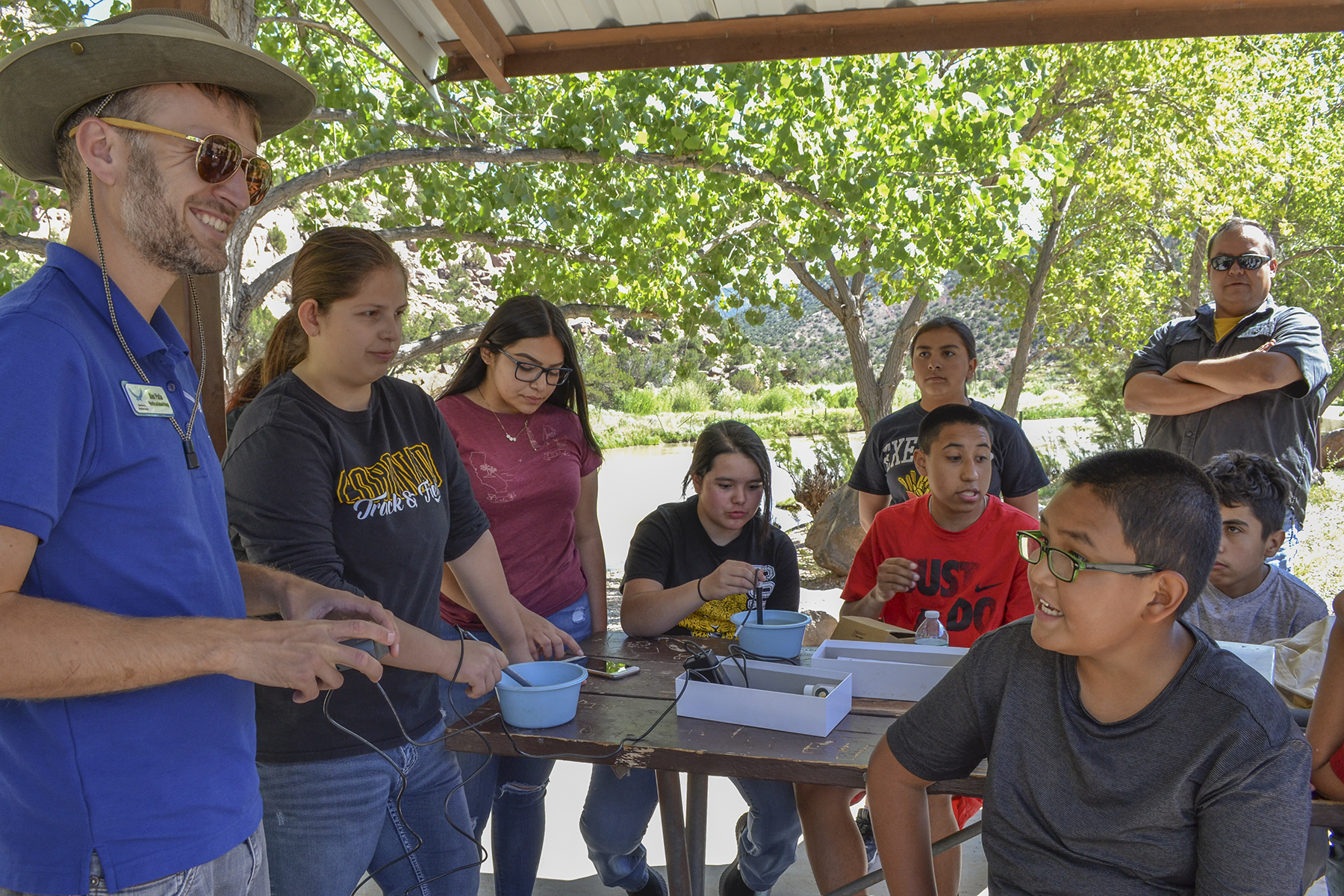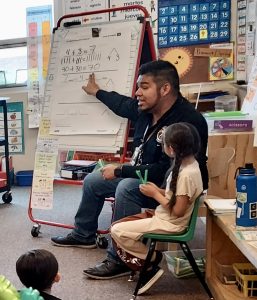Above: NM Wildlife Center’s Education & Outreach Manager Alex Patia (left standing) and Coronado High School science teacher Sergio Torres (right standing) guide students through a lesson on water quality testing on the Rio Chama.
Jemez Mountain Public School District is located about 30 miles west of the Abiquiú Lake, where many people come to enjoy the picturesque scenery, camping and water activities. Late this summer, the lake became barren of boats and swimmers due to a closure in response to the presence of toxic levels of blue-green algae. Cyanobacteria is normally present at low levels in many freshwater lakes, but under certain unknown conditions it can grow quickly, forming “blooms” that cause health risks in humans and animals.
When Coronado High School (CHS) science teacher and researcher Sergio Torres heard of the lake’s closure, he began thinking of ways to engage his students in research around the problem. He sought out the New Mexico Wildlife Center’s River Classroom program dedicated to teaching students in Rio Arriba County about ecology, wildlife and conservation related to waterways in their community. Additionally, Torres learned about the New Mexico Governor’s STEM Challenge and Torres made the connection to tie both opportunities together with his students.
The STEM Challenge Team is made up of 10 high school students plus two alternates who are all part of the Coronado Science and Engineering Club. Members include students from integrated science, biology and chemistry classes, some taking dual credit at Northern New Mexico College, as well as several middle school students. Coronado Middle School seventh and eighth grade teacher Matthew Coriz is club co-sponsor with Torres and will support the younger students with related research projects for the science and engineering fairs.
The 2019 STEM Challenge asks high school teams to answer the question, “How would you use technology to make the world a safer place?” The Coronado team’s answer is a multifaceted, multidisciplinary approach with an environmental focus. Their goal is to develop a real-time aquatic detection system using an engineered nanotechnology platform to monitor pollutants and biotic factors in order to keep New Mexico’s water systems safe.
The students are eager to understand more about the water condition and its effects. “We researched how to measure certain parameters in the water and why they closed down the lake because of blue alae blooms that were releasing toxins which harm your body,” said tenth grader Tom Rieck. “Hopefully we can find out what caused the blooms so we can stop it.”
They’re working collaboratively with Alex Patia, NM Wildlife Center’s Education & Outreach Manager, to conduct research on the Rio Chama just below the Abiquiú Dam. At the river’s edge, the students discussed how the lake feeds the river and other waterways that are sources of drinking water for people and animals throughout New Mexico and into Texas. The possible danger of toxic water has the potential to affect many living things.
They selected a flat access area at the river’s edge to serve as the base of operations to gather water samples and collect data. During a prior meeting, they met in the classroom to become familiarized with the tools and terms they are using during their research. Splitting up into small groups with older students leading the younger ones, they use electronic sensors and probes to measure parameters of dissolved oxygen, pH, nitrates, turbidity, conductivity and temperature of the water.
“We can simultaneously collect data on three parameters at once, and the sensor graphs it out while you’re recording, so it shows if there are any fluctuations,” explains Patia.
As part of their scientific method, they determine how many samples to collect and agree upon five-minute measurement times for each sample during every visit to the river, eight sessions in total over the next several months.
“Each time we’re here we’ll take data from different sections of the river. Why do we do that?” asked Patia.
“Because the water is different in different places,” said one student. “The parameters may be different,” added another.
“Yes, the goal is to keep coming back, so we see the changes not only in the different areas of the river but also throughout the seasons,” state Patia.
Jaylene Jacquez, a senior, enjoys being outdoors and in nature. “We’re using these parameters to check the water ecosystem. We’re out here for the hands-on activities and then we get to go back into the lab. Last year we didn’t have this opportunity, so this is new,” she said.
Torres points out that the sensors they currently use are large and take time to process the data, which is why the team is engineering a microfluidics chip and a more efficient platform to monitor water quality in real time. Funding for new equipment came from a LANL Foundation small grant.
“We’ve been researching and prototyping an autonomous water testing unit. We haven’t gotten very far in the prototyping stage but the parameters we’re using will be part of it,” said senior Nathaniel Cordova. “I like the engineering, the designing part and the research. And coming out and testing to see how the samples look.”
Being able to assess chemicals, pharmaceuticals and other pollutants and toxins in the water samples will show how they are potentially affecting DNA changes in bacteria and some higher organisms in the lab.
“We take a biological specimen like an immortalized cancer cell and add the water sample we’re testing to see if it will kill the cell or cause any damage to its normal function. That way we know the toxicity of the water,” Torres said. “We want to be able to better understand how these pollutants manifest in human health and recreational areas like this.”
Before leaving the river, they scout out spots to collect small organisms. Certain macroinvertebrates are pollution intolerant, so finding many of them in the river’s ecosystem indicates good water quality. Other organisms have a higher tolerance to pollution, and their dominance indicates water with higher toxicity.
“The little bugs and organisms can tell us a lot about water quality,” said Torres.
Using dip nets from the water’s edge and a vertical seine net in the river, the students gathered specimens and shared what they found. They sift through the debris and identify mayflies, nymphs and small clam shells indicating that the water quality is fair but not highly toxic. The tiny creatures are quickly returned back to the water.
The River Classroom program entails two visits each month—one at the river and one in the CHS science laboratory—through the end of the school year, excluding December. In the lab the students will spend more time on analyses, drawing graphs and talking about how to make sense of the data. They will also be able to test out their sensor when it is further along in development.
In addition to the high school team competing in the statewide Governor’s Challenge in December, the entire group will have opportunities to make presentations on their science and engineering, research and development project and draw conclusions about the way water quality fluctuates. They also hope to report why Abiquiú Lake became contaminated and how to prevent it from happening again.
The CHS Governor’s STEM Challenge Team — Bottom row, left to right: Nathaniel Cordova, Enriquez Jacquez, Monique Romero, Jaylenne Jacquez, Harley Binion, Angel Sanchez (Alternate); Mr. Sergio Torres (Sponsor). Top row, left to right: Mr. Matthew Coriz (Sponsor), Unica Velasquez, Rebecca Chacon, Elias Trujillo, Thomas Rieck, not pictured: Miguel Sanchez
The Impact of Triad Funding
Sixteen teams from the LANL Foundation’s seven-county service area in Northern New Mexico are registered for the STEM Challenge and will receive $1,000 in additional funding for materials and travel to the competition in Las Lunas. Coronado High School is 130 miles from the competition location, and the travel and overnight housing costs alone for 10 students and two adults are significant.
Although not directly supported by the Triad grant, the partnership with the Lab connected 19 businesses with the LANL Foundation, which is serving as fiscal sponsor for the corporate funding of the competition and managing $95,000 in award money to be distributed directly to students on the winning teams.
“This is what STEM jobs look like. It’s not just working some place far away at a tech company,” said Michael Dabrieo, Education Enrichment Director at the LANL Foundation. “This competition provides students the opportunity to apply the skills they are learning in school to solve real world problems that are affecting their local communities. Many rural schools don’t have the funding to offer experiences like this, and this competition provides them that access.”



